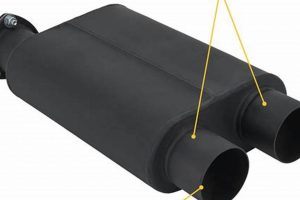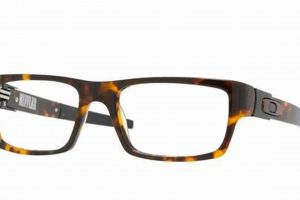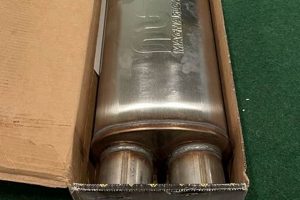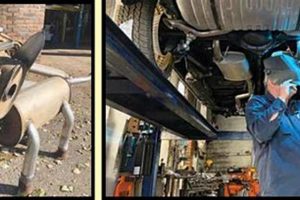A component employed in exhaust systems provides critical support. This part typically consists of metal, often steel, shaped and configured to secure the noise-reducing device to the vehicle’s undercarriage. An example is a U-shaped piece of metal bolted to the vehicle frame that cradles the muffler, preventing it from dragging or detaching.
The stability afforded by this hardware is essential for maintaining the integrity of the exhaust system. Without adequate support, the muffler could be subject to excessive vibration and stress, leading to premature failure and potential damage to other vehicle components. Historically, these supports have evolved from simple straps to more sophisticated designs capable of withstanding harsh environmental conditions and significant mechanical strain. This evolution reflects advancements in materials science and manufacturing techniques aimed at increasing durability and longevity.
Understanding the function and maintenance requirements of this seemingly small element is vital for vehicle owners and automotive technicians alike. Subsequent sections will delve into material selection, installation procedures, common failure modes, and best practices for ensuring long-term performance.
Essential Considerations for Exhaust Support Components
The following guidelines are designed to optimize the lifespan and functionality of the hardware used to secure exhaust components, ensuring vehicle safety and regulatory compliance.
Tip 1: Material Selection: Employ high-quality, corrosion-resistant materials such as stainless steel or aluminized steel. Inferior materials degrade rapidly, especially in regions with road salt applications.
Tip 2: Regular Inspection: Conduct routine visual inspections for signs of rust, cracks, or physical damage. Early detection prevents catastrophic failure and costly repairs.
Tip 3: Proper Installation: Adhere strictly to manufacturer-specified torque specifications during installation. Over-tightening can deform the component, while under-tightening allows excessive movement and vibration.
Tip 4: Vibration Dampening: Incorporate rubber insulators or similar dampening materials to minimize vibration transfer from the exhaust system to the vehicle chassis. This reduces stress on the hardware and surrounding components.
Tip 5: Load Distribution: Ensure that the weight of the exhaust system is evenly distributed across all support points. Uneven loading can lead to premature failure of individual components.
Tip 6: Environmental Protection: Apply a protective coating to exposed metal surfaces, especially in areas prone to corrosion. This barrier shields the component from moisture, road salt, and other corrosive elements.
Tip 7: Replacement Schedule: Establish a proactive replacement schedule based on vehicle usage and environmental conditions. Waiting for complete failure can result in secondary damage and safety hazards.
Adherence to these recommendations will significantly extend the service life of these critical components, reducing the risk of exhaust system failure and maintaining optimal vehicle performance.
The subsequent section will address common failure modes associated with exhaust support hardware and strategies for effective troubleshooting and repair.
1. Material Durability
The longevity and functionality of a vehicle’s exhaust system are intrinsically linked to the durability of the materials used in its construction, particularly the supports. The ability of these components to withstand environmental stressors and mechanical loads directly impacts the overall system’s reliability and performance.
- Corrosion Resistance
The selection of materials inherently resistant to corrosion is paramount. Steel alloys, particularly stainless steel and aluminized steel, are frequently employed due to their ability to resist oxidation and degradation from exposure to moisture, road salts, and other environmental contaminants. The selection of an inferior material can drastically shorten the service life of the hardware, leading to premature failure and potential damage to other exhaust system components.
- Tensile Strength
The capacity of the component to withstand tensile forces is critical. Exhaust systems are subjected to significant vibration and stress during vehicle operation. High-tensile-strength materials, such as hardened steel, ensure that the support hardware does not deform or fracture under load. Failure to use materials with adequate tensile strength can result in component failure, potentially leading to the exhaust system detaching from the vehicle.
- Fatigue Resistance
Repeated exposure to mechanical stress can lead to material fatigue. The continuous vibration and thermal cycling experienced by exhaust systems can induce microscopic cracks in the support hardware. Materials with high fatigue resistance, often achieved through specific alloy compositions and manufacturing processes, are essential for ensuring long-term reliability and preventing catastrophic failures. The consequences of fatigue failure can range from increased noise levels to complete exhaust system detachment.
- Thermal Stability
Exhaust systems operate at elevated temperatures, and the support hardware must be capable of maintaining its structural integrity across a wide temperature range. Materials with high thermal stability resist deformation and weakening at elevated temperatures. The use of materials with inadequate thermal stability can result in creep, distortion, and ultimately, failure of the component, compromising the stability of the exhaust system.
In conclusion, the selection of materials for these supports is a critical engineering decision that directly influences the reliability and lifespan of the vehicle’s exhaust system. Consideration of corrosion resistance, tensile strength, fatigue resistance, and thermal stability is essential for ensuring that the hardware can withstand the harsh operating conditions inherent in automotive applications. Failure to prioritize these material properties can result in premature component failure, increased maintenance costs, and potential safety hazards.
2. Vibration Reduction
The operational environment of vehicle exhaust systems inherently involves substantial vibration, originating from engine combustion and road surface irregularities. This vibration, if unchecked, can impart significant stress on the supporting hardware, including those used to secure the muffler. Therefore, the ability to mitigate and dampen these vibrations is a critical design consideration for these components, directly impacting their longevity and the overall system’s integrity. The effectiveness of vibration reduction mechanisms directly influences the lifespan of the support, preventing premature fatigue failure and maintaining the secure positioning of the muffler. For instance, a bracket lacking adequate vibration dampening could experience accelerated wear, leading to cracks and eventual separation, resulting in increased noise levels and potential damage to other vehicle components.
Implementations for vibration reduction often involve the strategic use of elastomeric insulators. These insulators, typically made of rubber or synthetic polymers, are positioned between the bracket and the vehicle chassis, effectively absorbing and dissipating vibrational energy. The choice of insulator material and its configuration is carefully engineered to achieve optimal damping characteristics. A common example is the use of rubber grommets or hangers that isolate the muffler from direct contact with the vehicle frame. Furthermore, the design of the component itself can incorporate features that minimize vibration amplification. This may include optimizing the shape and thickness of the metal structure to reduce resonant frequencies and dampen vibrational modes.
In summary, vibration reduction is an indispensable function of muffler supports. It safeguards against premature failure, minimizes noise transmission, and maintains the structural integrity of the exhaust system. The strategic integration of elastomeric insulators and vibration-dampening design features are paramount in achieving effective vibration reduction, contributing to the long-term reliability and operational performance of the vehicle. Neglecting these considerations can lead to accelerated wear, increased noise, and potential safety hazards, underscoring the practical significance of understanding and implementing effective vibration reduction strategies.
3. Secure Attachment
The effectiveness of a muffler support hinges on its ability to provide secure attachment. This attachment dictates the device’s positional stability relative to the vehicle chassis. Loss of secure attachment, stemming from corrosion, mechanical failure, or improper installation, initiates a cascade of adverse effects. For instance, a detached or loosely secured muffler can vibrate excessively, amplifying noise and potentially impacting ground clearance. A real-world example involves a corroded bracket, weakening to the point where the muffler drags on the road surface, causing physical damage to both the exhaust system and the road itself. Understanding the dynamics of secure attachment is crucial for preemptive maintenance and ensuring vehicle safety.
Proper installation techniques and the use of appropriate fasteners are critical elements in maintaining secure attachment. Over-tightening fasteners can deform the bracket, reducing its structural integrity. Conversely, under-tightening allows movement, leading to accelerated wear and eventual detachment. Thread-locking compounds are often used to prevent loosening due to vibration. Furthermore, the design of the bracket itself plays a significant role. Brackets with multiple attachment points or those that distribute the load over a wider area tend to provide a more secure and stable connection. In practical applications, mechanics frequently reinforce existing brackets with additional welds or supplementary supports to enhance secure attachment in high-stress environments, like off-road vehicles or those subjected to harsh weather conditions.
In summary, secure attachment is not merely a static condition but rather a dynamic interaction between the component, the exhaust system, and the vehicle itself. Ensuring this attachment involves careful material selection, precise installation procedures, and ongoing inspection. Failure to prioritize secure attachment compromises exhaust system integrity, introduces potential safety hazards, and undermines the overall performance and longevity of the vehicle. The practical significance of understanding and maintaining secure attachment cannot be overstated.
4. Load Distribution
Effective management of exhaust system weight and vibration is crucial for longevity and safe operation. Load distribution, in the context of a muffler support, refers to how the weight and forces exerted by the muffler are dispersed across the structure of the support and its attachment points to the vehicle.
- Stress Concentration Mitigation
Uneven weight distribution concentrates stress at specific points, potentially leading to premature failure of the support or its mounting hardware. Strategic design and placement aim to distribute the load evenly, minimizing stress concentrations. For example, a bracket with a wide base and multiple mounting points spreads the weight more effectively than a single-point attachment. Ignoring this can result in cracks forming at the attachment points, eventually leading to complete failure of the support.
- Material Selection and Geometry
The materials employed and the geometric configuration of the hardware directly influence its capacity to handle distributed loads. High-strength alloys, combined with optimized shapes such as reinforced ribs or gussets, enhance the support’s ability to bear weight without deformation. Conversely, using low-grade materials or a poorly designed geometry can lead to sagging or bending of the support under the muffler’s weight, compromising its functionality.
- Vibration Dampening and Load Distribution Synergy
Vibrational forces, amplified by uneven loading, accelerate wear and tear on the bracket and its attachment points. Integrating vibration-dampening elements, such as rubber insulators, into the bracket’s design not only reduces noise but also mitigates the impact of vibration on load distribution. For instance, if a bracket lacks proper insulation, vibrations can cause the mounting bolts to loosen over time, leading to an imbalance in load distribution and eventual failure.
- Environmental Factors and Load Considerations
Environmental factors, such as corrosion and thermal expansion, can alter the structural integrity of the support and impact its ability to effectively distribute the load. Rust weakens the metal, making it more susceptible to deformation under weight. Similarly, extreme temperature fluctuations can cause expansion and contraction, placing additional stress on the attachment points. Regularly inspecting and maintaining the bracket, including applying protective coatings, helps to mitigate these environmental effects and preserve its load-bearing capacity.
The multifaceted nature of load distribution within a muffler support system underscores the importance of comprehensive design, material selection, and maintenance practices. An effective approach to load distribution not only extends the lifespan of the support itself but also protects other exhaust system components and contributes to overall vehicle safety and performance.
5. Corrosion Resistance
The operational environment of a vehicle exhaust system presents a significant challenge to the longevity of its components. Exposed to a relentless barrage of moisture, road salts, and varying temperatures, muffler supports are particularly vulnerable to corrosion. The chemical process of corrosion weakens the structural integrity of the metal, diminishing its capacity to bear the muffler’s weight and withstand vibrational forces. The selection of materials inherently resistant to corrosion is therefore a critical design consideration, directly impacting the lifespan and reliability of the support system. For instance, a support constructed from untreated carbon steel, when exposed to winter road conditions, will exhibit surface rust within a matter of weeks. This rust progressively weakens the metal, potentially leading to component failure and separation of the muffler from the vehicle.
Practical applications of corrosion-resistant materials significantly extend the service life of the hardware. Stainless steel alloys, known for their chromium content, form a passive oxide layer that inhibits further corrosion. Aluminized steel, featuring a protective aluminum coating, provides another effective barrier against environmental degradation. In regions with harsh climates or prevalent road salt usage, the implementation of these materials is not merely an option but a necessity. Furthermore, protective coatings, such as zinc plating or powder coating, can provide an additional layer of defense, mitigating the corrosive effects of exposure. Routine inspection and maintenance, including the application of rust inhibitors, further bolster the component’s resistance to corrosion.
In conclusion, corrosion resistance is an indispensable attribute for muffler supports, representing a crucial intersection of material science and automotive engineering. Its impact transcends mere material selection, influencing the overall safety, reliability, and economic viability of vehicle operation. Understanding the principles of corrosion and implementing appropriate mitigation strategies remains paramount in ensuring the long-term performance and integrity of exhaust systems. Failure to address this challenge can result in premature component failure, increased maintenance costs, and potential safety hazards, underscoring the practical significance of prioritizing corrosion resistance in all aspects of muffler support design and maintenance.
6. Proper Alignment
The structural integrity and operational efficiency of a vehicle’s exhaust system are directly contingent upon the precise positioning of its components. This precise positioning, termed “proper alignment,” is intrinsically linked to the function of the hardware securing the muffler. An improperly aligned muffler introduces undue stress on the bracket, accelerating wear and potentially leading to premature failure. For instance, if the exhaust pipe leading to the muffler is forced out of its natural position, the resulting tension can cause the bracket to bend or fracture over time. This misalignment also affects exhaust flow, potentially reducing engine performance and fuel efficiency. Accurate alignment ensures the muffler is supported without imposing unnatural stress, maximizing the lifespan of both the muffler and its support.
Practical applications of this principle are evident in standard automotive repair procedures. When replacing a muffler or any component of the exhaust system, technicians routinely check and correct the alignment of the entire system before tightening the bracket fasteners. Specialized tools and techniques are employed to ensure the muffler is properly positioned relative to the exhaust pipe and vehicle chassis. Failure to perform this alignment check can result in recurring problems, such as broken supports, exhaust leaks, and diminished vehicle performance. Regularly inspecting the exhaust system for signs of misalignment, such as unusual vibrations or exhaust noise, allows for early intervention and prevents more costly repairs.
In summary, proper alignment is not a mere aesthetic consideration but a fundamental requirement for the reliable operation of a vehicle’s exhaust system. It directly impacts the structural integrity of the support, influences exhaust flow efficiency, and contributes to overall vehicle performance. Recognizing and addressing alignment issues during installation and maintenance procedures is paramount to ensuring the longevity and optimal functionality of both the muffler and its supporting structure.
7. Exhaust Support
Exhaust support encompasses a range of components designed to secure and stabilize the exhaust system within a vehicle’s chassis. As a critical subset of exhaust support, the muffler bracket specifically addresses the mounting and stabilization of the muffler, a key noise-reduction device within the system. Understanding the broader context of exhaust support elucidates the multifaceted role and importance of the individual muffler bracket.
- Vibration Dampening Mechanisms
Exhaust systems are inherently subject to significant vibration, which can propagate through the vehicle structure and cause excessive noise and stress on system components. Comprehensive exhaust support systems often incorporate vibration dampening mounts, typically made of rubber or similar elastomeric materials, to isolate the exhaust from the chassis. The muffler bracket, as a crucial point of contact between the muffler and the vehicle, benefits significantly from such dampening mechanisms. Failure to adequately dampen vibration can lead to premature fatigue and failure of the bracket, resulting in increased noise and potential exhaust leaks.
- Corrosion Protection Strategies
Exposure to harsh environmental conditions, including road salt, moisture, and extreme temperatures, accelerates corrosion within exhaust systems. Exhaust support systems, including muffler brackets, must be constructed from corrosion-resistant materials or be treated with protective coatings to extend their lifespan. Galvanized steel, stainless steel, and specialized paints are commonly employed to mitigate corrosion. A compromised muffler bracket, weakened by corrosion, can lose its ability to securely support the muffler, leading to exhaust system damage and safety hazards.
- Load Distribution Considerations
The weight of the exhaust system, particularly the muffler, must be effectively distributed across multiple support points to prevent excessive stress on any single component. A well-designed exhaust support system accounts for the muffler’s weight and positioning, ensuring that the load is evenly distributed among the various brackets and hangers. The muffler bracket plays a vital role in this distribution, as it often bears a significant portion of the muffler’s weight. Improper load distribution can result in bracket failure, leading to misalignment of the exhaust system and potential damage to other vehicle components.
- Thermal Expansion Accommodation
Exhaust systems experience significant temperature fluctuations during vehicle operation, leading to thermal expansion and contraction of the metal components. Exhaust support systems must be designed to accommodate these dimensional changes without inducing excessive stress on the system. Flexible hangers and sliding joints are often incorporated to allow for thermal movement. The muffler bracket, as a fixed point of attachment, must be designed to minimize stress resulting from thermal expansion, preventing cracking or distortion of the bracket or the surrounding exhaust components.
In summary, the muffler bracket’s function is deeply intertwined with the overarching principles of exhaust support. Effective vibration dampening, corrosion protection, load distribution, and accommodation of thermal expansion are all critical for ensuring the long-term reliability and performance of both the muffler bracket itself and the entire exhaust system.
Frequently Asked Questions
This section addresses common inquiries concerning the purpose, maintenance, and potential issues related to the automotive component responsible for securing the muffler.
Question 1: What is the primary function of this component?
The primary function is to provide physical support for the muffler, a critical component of the exhaust system. This support prevents the muffler from dragging on the ground, protects it from impact damage, and reduces stress on the exhaust piping.
Question 2: What materials are commonly used in the construction of this component?
These supports are typically constructed from steel or steel alloys due to their strength and durability. Stainless steel or aluminized steel are often preferred for their superior corrosion resistance.
Question 3: What are the common signs of a failing or damaged component?
Common signs include excessive rattling or clunking noises emanating from the exhaust system, visual evidence of rust or corrosion, and physical damage such as cracks or bends in the bracket.
Question 4: Is it possible to replace this component independently, or is it necessary to replace the entire exhaust system?
This component is generally replaceable as a standalone item, provided the muffler and exhaust piping are not severely damaged. Replacement involves removing the old bracket and installing a new one, ensuring proper alignment and secure fastening.
Question 5: What factors contribute to the premature failure of this component?
Common factors include exposure to road salt and other corrosive elements, excessive vibration, physical impact damage, and improper installation or tightening of fasteners.
Question 6: Does the failure of this component pose any safety risks?
Yes, a detached muffler can pose several safety risks. It can drag on the ground, creating a fire hazard. It can also damage the exhaust system, leading to exhaust leaks, which can expose vehicle occupants to dangerous carbon monoxide fumes.
In summary, recognizing the function, materials, and potential failure modes of this component is essential for maintaining the integrity and safety of a vehicle’s exhaust system.
The next section will delve into practical guidance on selecting appropriate replacement hardware and executing effective installation procedures.
Muffler Bracket
This exploration has illuminated the pivotal role of the muffler bracket within a vehicle’s exhaust system. From material selection and vibration reduction to secure attachment, load distribution, and corrosion resistance, each aspect contributes to the overall reliability and longevity of this critical component. Proper alignment and consistent maintenance further ensure that the bracket functions optimally, preventing potential safety hazards and maintaining exhaust system efficiency.
The stability and performance of a vehicle’s exhaust system depend heavily on the integrity of the support hardware. Therefore, diligent inspection, informed selection of replacement parts, and adherence to proper installation techniques are paramount. Prioritizing these factors will ensure sustained functionality, contribute to vehicle safety, and safeguard against costly repairs. Investing in quality supports and maintaining a proactive approach to exhaust system maintenance represents a responsible commitment to vehicle longevity and operational security.




![Buy Henry Muffler Online - Best Car Muffler [Year] Best Mufflers for Cars & Trucks | Performance, Sound & Durability Upgrades Buy Henry Muffler Online - Best Car Muffler [Year] | Best Mufflers for Cars & Trucks | Performance, Sound & Durability Upgrades](https://dnamufflers.com/wp-content/uploads/2025/10/th-897-300x200.jpg)
![Quiet Practice: Best Saxophone Muffler Options [Guide] Best Mufflers for Cars & Trucks | Performance, Sound & Durability Upgrades Quiet Practice: Best Saxophone Muffler Options [Guide] | Best Mufflers for Cars & Trucks | Performance, Sound & Durability Upgrades](https://dnamufflers.com/wp-content/uploads/2025/10/th-889-300x200.jpg)

